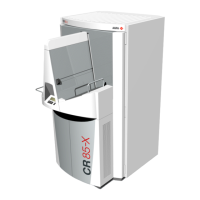8
4451C EN 2013-04-30Introducing the CR 85-X
CR 85-X DIGITIZER
CR 85-X features
The CR 85-X scans the exposed CR image plate, converts the information into
digital data and automatically transfers the image to the image processing
station for further processing and visualization.
The CR 85-X requires but little manual interaction. All you have to do, after
exposure and identification of the cassette, is to place it in the input buffer of
the CR 85-X. You can deposit up to 10 cassettes of different sizes
simultaneously in the input buffer. The Digitizer takes in the cassettes one by
one. The Digitizer reads the demographic data and routing information from
the memory chip in the cassette, opens the cassette, removes the image plate
and scans the latent image by means of a sweeping laser beam.
Once the image is digitized, the cassette is returned to the output buffer to be
used for new exposures. After a full Digitizer cycle, the plate has turned 180°
in the cassette.
Depending on the X-ray intensity which has affected the phosphor during the
exposure, more or less light will be emitted during laser scanning. The light is
converted into an electrical signal. This signal is then converted into a digital
bit stream. Once converted into digital form, the digitized image is
transferred to the image processing station for further processing and
visualization.
Further features of the CR 85-X include:
The CR 85-X permits assigning the status ‘emergency’ to an image. An emer-
gency image will be given priority by the image processing station.
The CR 85-X permits re-erasing an image plate before re-using it. In specific
cases, this is necessary to prevent ghost images caused by previous exposures or
stray radiation from interfering with the image of interest. You can erase a
batch of up to 9 image plates.

